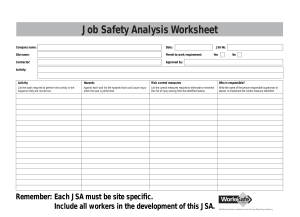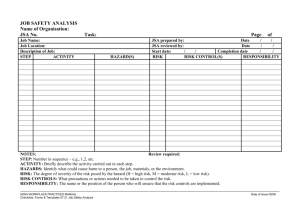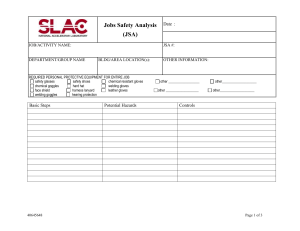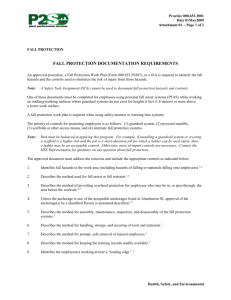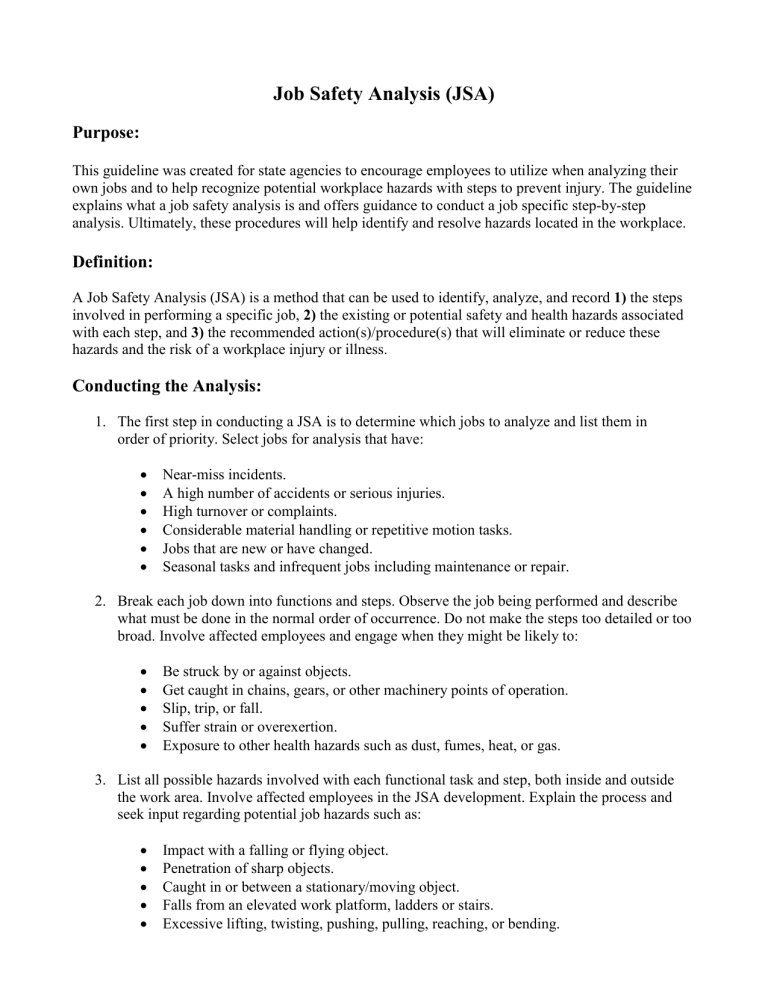
Job Safety Analysis (JSA) Purpose: This guideline was created for state agencies to encourage employees to utilize when analyzing their own jobs and to help recognize potential workplace hazards with steps to prevent injury. The guideline explains what a job safety analysis is and offers guidance to conduct a job specific step-by-step analysis. Ultimately, these procedures will help identify and resolve hazards located in the workplace. Definition: A Job Safety Analysis (JSA) is a method that can be used to identify, analyze, and record 1) the steps involved in performing a specific job, 2) the existing or potential safety and health hazards associated with each step, and 3) the recommended action(s)/procedure(s) that will eliminate or reduce these hazards and the risk of a workplace injury or illness. Conducting the Analysis: 1. The first step in conducting a JSA is to determine which jobs to analyze and list them in order of priority. Select jobs for analysis that have: Near-miss incidents. A high number of accidents or serious injuries. High turnover or complaints. Considerable material handling or repetitive motion tasks. Jobs that are new or have changed. Seasonal tasks and infrequent jobs including maintenance or repair. 2. Break each job down into functions and steps. Observe the job being performed and describe what must be done in the normal order of occurrence. Do not make the steps too detailed or too broad. Involve affected employees and engage when they might be likely to: Be struck by or against objects. Get caught in chains, gears, or other machinery points of operation. Slip, trip, or fall. Suffer strain or overexertion. Exposure to other health hazards such as dust, fumes, heat, or gas. 3. List all possible hazards involved with each functional task and step, both inside and outside the work area. Involve affected employees in the JSA development. Explain the process and seek input regarding potential job hazards such as: Impact with a falling or flying object. Penetration of sharp objects. Caught in or between a stationary/moving object. Falls from an elevated work platform, ladders or stairs. Excessive lifting, twisting, pushing, pulling, reaching, or bending. Exposure to vibrating power tools, excessive noise, cold or heat, or harmful levels of gases, vapors, liquids, fumes, or dusts. Repetitive motion. Electrical hazards. Light (optical) radiation (i.e. welding operations, etc.). Water (potential for drowning or fungal infections caused by wetness). 4. Develop solutions that will eliminate or reduce each identified hazard listed. Be sure to involve employees in discussing possible solutions. Identify potential solutions in order of effectiveness. Can the hazard be eliminated? Do we need to hire a specialized professional? Is there a safer or more efficient way to do the job task? (Ex: guards, ergonomic changes, job setup, improved machinery, personal protective equipment, specialized training)? Benefits to properly conducting a JSA include but are not limited to: Better understanding and knowledge of each job. Improved safety attitude from employees engaged in safety operations. Improved job methods. Fewer job interruptions. Higher quality and increased productivity. Reduced workplace injuries. *Sample JSA template and example attached. Each JSA must be adapted to fit the particular needs of your facility. Scenario: Palletized boxes of copy paper are delivered from a delivery truck. The pallets are transported with a pallet jack to a storage room. Plastic shrink wrap holding the boxes together is removed. Employees lift the boxes of paper from the pallet to a cart at floor level. The boxes of paper are delivered and unloaded by cart to each location and unloaded into each locations supply room. Example JOB SAFETY ANALYSIS JOB TITLE: Facility Maintenance JSA No. ____________ DATE: 3/8/16 NEW REVISED Page 1 of 1 ORGANIZATION: Agency SUPERVISOR: ANALYSIS PERFOMED BY: Safety Manager LOCATION: Loading Dock DEPARTMENT: Maintenance REVIEWED BY: Supervisor SEQUENCE OF BASIC JOB STEPS POTENTIAL HAZARDS RECOMMENDED ACTION OR PROCEDURE 1. Using the pallet jack, deliver pallet to storage room. • • • • 2. Remove plastic wrapping from pallets of paper boxes with a box cutter. 3. Paper boxes are lifted onto cart for transport. Lower back, arm, and shoulder strain from pulling. • Pinched toes under pallet jack. • Slip, trip, fall. • Cuts or punctures. • Lacerations. • Lower back, arm, and shoulder strain from lifting. • Slip, trip, fall. All employees using pallet jacks formally trained. Safe pallet jack handling techniques must be used. Safety toed and slip resistant shoes must be worn while operating pallet jack. • Use cut resistant gloves when using a knife. • Always keep guide hand placement away from motion of knife and cut away from your body. • • • • Utilize proper lifting technique. (Reference handout) Lift within power zone. (Reference handout) Use a rolling ladder to assess top layers. Team lift when help is available. 4. Carts are pushed into elevator and brought to each floors supply closet. • Lower back, arm, and shoulder strain from pushing. • Slip, trip, fall. • Inspect and maintain carts. • Always push and do not pull. • Maintain safe operating speed. • Utilize a spotter to assist. 5. Paper boxes are lifted from cart to the supply closet. • • Utilize proper lifting technique. (Reference handout) • Lift within power zone. (Reference handout) • Team lift when help is available. Lower back, arm, and shoulder strain. • Slip, trip, fall. Sample JSA Form JOB SAFETY ANALYSIS JOB TITLE: JSA No. ____________ DATE: NEW: REVISED Page SEQUENCE OF BASIC JOB STEPS of ORGANIZATION: SUPERVISOR: ANALYSIS PERFOMED BY: LOCATION: DEPARTMENT: REVIEWED BY: POTENTIAL HAZARDS RECOMMENDED ACTION OR PROCEDURE This guideline has been developed by the Bureau of State Risk Management, Department of Administration and is available for download. *For additional JSA information see OSHA JSA Publication.
